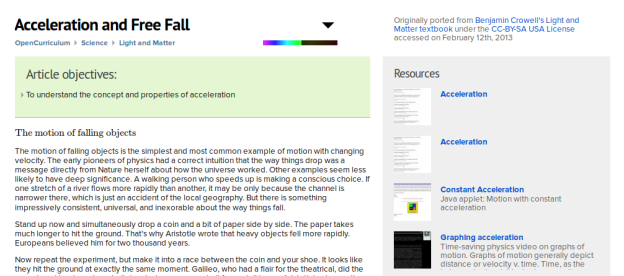It gives me a tonne of joy and pride to announce that OpenCurriculum is now live. We are going live with 43 high-quality articles (with a lot more in the pipeline) and ~300 associated learning resources, including quizzes, videos, games, websites, etc. All for free! At this point, this is what our home page looks like:

While this is not a main launch of our platform, as we are very much gearing towards bringing you and your contributions in into the experience of using OpenCurriculum, I would still like to share with you some of the amazing things we have released today and give you a little sneak peek into what we are spending our near future energies on, leading up to our launch.
Article and resource links

Very early, while browsing our growing collection of articles, you will observe each article has been linked to related open educational resources from the web. This is extremely useful to teachers and learners alike, as it models their usage patterns in looking for various kinds of content related to a particular topic. While the article will aim to serve as the definitive and canonical “textbook” resource, the related rich resources will extend the capabilities of the article’s text/images to broaden the range of resources one can learn from. This list is ever changing, and is going to depend entirely on user inputs and ratings in the future.
Search

You will also notice the really big focus and presence of search all throughout your usage experience. Search has been an extremely crucial aspect of this release, as it points to our continued commitment to reduce the time it takes to look for exactly the resources you are looking for, and reduce wasted time in the process. So, apart from building a search functionality with rich indexing of content, we are introducing powerful search filters, for high-speed searches and filtering through all resources on the website. As we bring in more content and evolve the search tools further, we promise to make these filters even more versatile with tighter control on what you are looking for.
Support for LaTeX in Math

Very early into planning this release, we realized how important math equation rendering on the website was. Not many pure web resources support its rendering on the web browser, with inline math seeming like a goal for the future shown to us in Minority Report. And so, we’d like to announce the support for true LaTeX rendering in all our articles. This means that every user on OpenCurriculum will be able to write and collaborate on LaTeX math article in our text editors (after our forthcoming releases). We expect this to explode with the math community’s interest in creating and sharing material on the web.
What’s coming ahead
Okay, let me try to tell you just enough such that we keep some excitement in anticipation for our future releases going.
Today, OpenCurriculum is a website. Articles, images, resources, search – everything you would expect a resource aggregator in the Web 1.0 world to be. But we are thinking far ahead, and believe in the power of community and rich social engagement in creating and sharing content, and that is what a real platform is all about. In trying to be the largest high-quality article repository on the web, we need a large community and lots of actively created and edited articles, much like Wikipedia and open source software. It is this direction that we are embracing to the fullest – so expect to see a lot more of YOU being at the center of activity on OpenCurriculum.
Until then, to put it in the words of one of our fans, OpenCurriculum is OPEN!



















